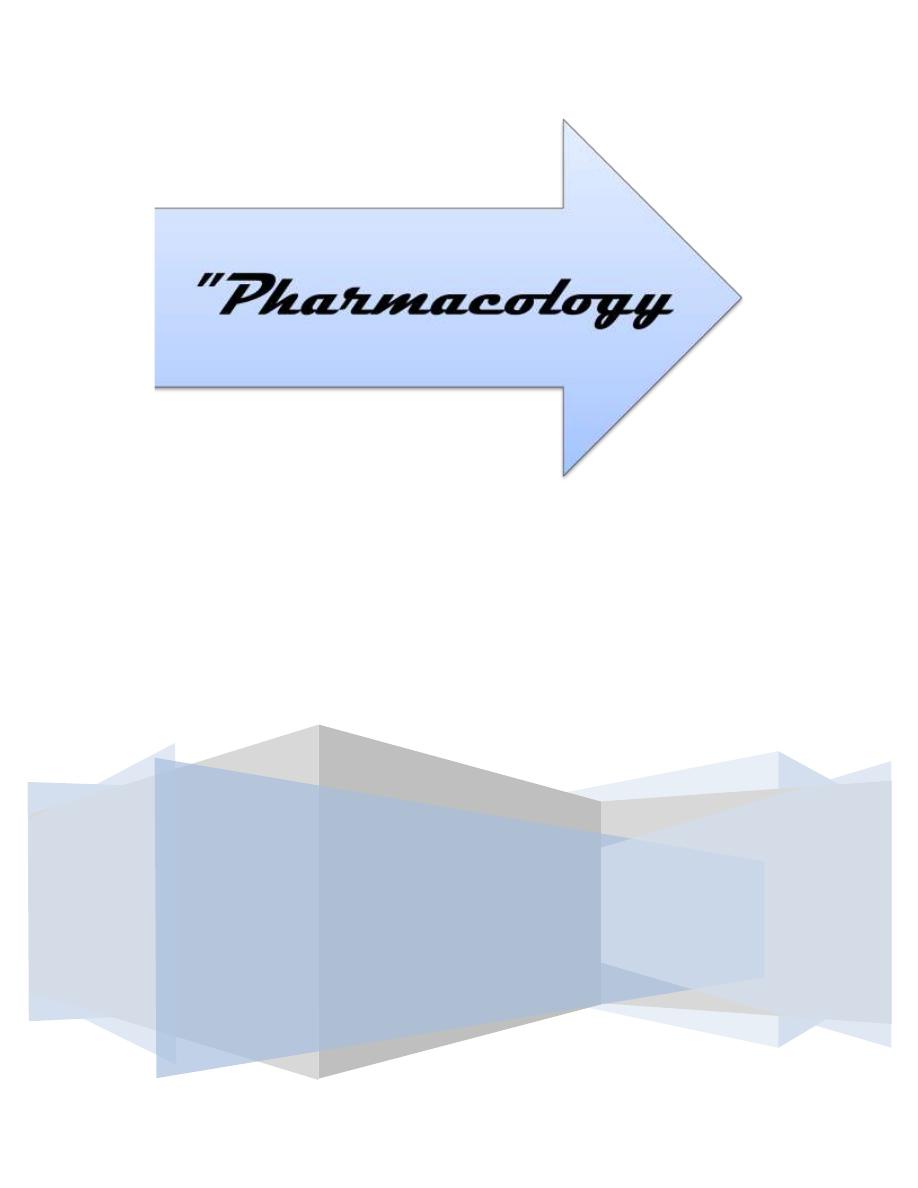
Sunday 14 / 12 / 2014
©Ali Kareem 2014-2015
Name
:
______________________________
Class
:
_______________________________
مكتب اشور لالستنساخ
Local Anesthetics
Lecture 2
Total lectures NO. 29
Dr. Huda Al-Qadhi

Local Anesthetics
Local anesthetics (LA) are drugs employed to produce a transient and
reversible loss of sensation in a circumscribed area of the body by
interfering with nerve conduction (both sensory and motor) and without
loss of consciousness.
Useful drugs must be:
Water soluble
Sterilizable by heat
Have a rapid onset of effect
Have a duration of action suitable to the operation performed
Be non-toxic
Leave no local after effects
Mode of action:
LA prevent the nerve impulses from arising and propagating by
interfering with the rate of rise of the depolarization phase of the action
potential. Also the threshold of excitation increases and the impulse
conduction slows , finally the cell does not depolarize sufficiently to fire
and therefore propagating action potential fails to occur. LA accomplish
this by reducing the passage of Na+ through the voltage gated Na+
channels.

Increase in extracellular Ca+ partially antagonizes the action of LA,
this is probably because LA compete with Ca ions for a site in the nerve
membrane that controls the passage of Na+ through these channels
The fibers in the nerve trunks are affected according to:
1- Fiber diameter:
The small fibers are first affected (autonomic, sensory) and then the
larger
myelinated motor fibers.
Type B(preganglionic autonomic) then type C (dorsal root for pain)
and then the small type A delta fiber (pain and temperature) and
then type A beta (touch and pressure) and then type A alpha
(proprioception,motor).
The time of onset of action is shorter for the smaller fibers and the
concentration of the drug required is also less.
2- Myelination:
Myelinated nerves tend to become blocked before the unmylinated nerve
of the same diameter , for this reason pre-ganglionic B fibers may be
blocked before the unmyelinated C fibers involved in pain transmission.
For myelinated fibers at least two successive nodes must be blocked by
The LA to halt impulse propagation.

3- Firing frequency (conduction velocity):
LA effect is more marked on fibers of higher frequencies of
depolarization and longer periods of depolarization especially pain
fibers. Motor fibers fire at a slower rate and have a shorter action
potential duration .
4- Fiber position:
The location of the fiber in the peripheral nerve bundle whether sensory
or motor is important. Fibers located circumferentially are blocked first
because they are the first to be exposed to the drug therefore it is not
uncommon that motor nerves are blocked before the sensory in large
mixed nerve.
The general order of loss of function is as follows:
1-pain 2-temp. 3-touch 4-proprioception 5-skeletal m. tone.

Classification of LA:
1- According to chemistry:
a- Ester compounds
b- Amide compounds
structurally all LA consist of a hydrophilic amino group linked through a
connecting group (either ester or amide) to a lypophilic aromatic residue.
Ester compounds: are hydrolyzed by the liver and plasma esterases
e.g. cocaine, procaine (S), benzocaine, tetracaine(L).
Amide compounds: are dealkylated in the liver
e.g.
lidocaine
(I),
prilocaine(I),
cinchocaine,
bupivacaine(L),
mepivacaine(I), Ropivacaine(L)
S= short acting I=intermediate acting L=long action
2- According to clinical usage (methods of administration):

a- surface anesthesia: as solutions jellies, creams or lozenges
e.g. benzocaine, prilocaine and lidocaine (the last two are preferred).
b- Infiltration anesthesia: to paralyze the sensory nerve endings and
the small cutaneous nerves
e.g. lidocaine, bupivacaine , procaine, mepivacaine, prilocaine (the first
two are preferred).
c- Regional anesthesia: Four types:
1- Intravenous: e.g. lidocaine, prilocaine
2- Nerve block: e.g. lidocaine, bupivacaine
3- Extradural(epidural): e.g. lidocaine, bupivacaine
4- Sub-archnoid (intra thecal) or called spinal anesthesia:
e.g. tetracaine(preferred), lidocaine, mepivacaine .

Pharmacokinetics:
LA are weak bases and are usually water insoluble for this reason
they are usually prepared in an acidic salt solution (hydrochloride salt)
which is water soluble and stable.
At tissue PH and depending on the Pka of the agent the drug exists as
unchanged form or as a positively charged amonium cation , the
unchanged form is lipophilic and enters the nerve cells , the cation is
thought to block the Na+ channel receptor site while the unchanged
form is very important for rapid penetration of biological membranes
and because the local anesthetic receptor is not readily accessible from
the external side of the cell membrane ,This partly explains why dentists
and surgeons observe that LA are much less effective when they are
injected into infected tissues. Infected tissues have a low extra-cellular
PH and therefore a very low fraction of non ionized LA is available for
diffusion into the cell, this is in addition to the risk of spread of
infection.
By injection or infiltration LA are usually effective in five minutes for
duration of 1-5 hours. Absorption after topical application varies
according to the drug used but can be extremely rapid and can give
blood levels comparable to those obtained by injection.
Defective liver function due to cellular insufficiency or liver blood
flow (e.g. heart failure or beta blockade) may prolong the half life of
both types of LA especially the amides. However this is important only
with large and repeated doses.

Prolongation of action of LA by vasoconstrictors:
Adrenaline and less commonly nor adrenaline are combined with LA to
double its duration of action ,the concentration used is:1:200000 –
1:400000
Dentists 1:80000
Note: 1:200000 means 1000 mg / 200000 ml = 5 microgram per ml
These vasoconstrictors delay the absorption of LA into the circulation
and thus its removal from the site of application thereby prolonging
there duration of action and reducing their systemic reactions.
Vasoconstrictors should not be used for nerve block of an extremity e.g.
fingers, nose, penis because it leads to damage of the organ and
gangrene due to the cutting of blood supply.
Termination of the effect of the vasoconstrictors is done by injection
of phentolamine (alpha blocker) into the site where the operative job is
done.
Adrenaline and nor adrenaline can be absorbed to affect the heart and
circulation and also reduce the plasma k which can be dangerous in
cardiovascular diseases or with general anesthetics that sensitize the
heart to catecholamines (e.g. halothane ), and with tricyclic anti
depressants and potassium losing diuretics. for these cases an alternative

vasoconstrictor is used known as felypressin (synthetic vasopressin).
This drug in therapeutic concentrations does not have those side effects
on the heart and the blood pressure.
Adverse reactions (toxicity):
1- CNS effects: The important toxic effect of most LA are in the CNS ,
all LA are capable of producing a spectrum of central effects including
:light headedness or sedation, restlessness, nystagmus, parasthesias of
the face and tongue and tonic clonic convulsions. Severe convulsions
may be followed by coma with respiratory and CVS depression.
Convulsions are treated by diazepam 0.1 mg – 0.2 mg / kg.
2- CVS effects:
With the exception of cocaine all local anesthetics are vasodilators.
LA have qunidine like action on the heart.
Patients with pre-existing CVS disease may develop heart block and
other disturbances of cardiac electrical function at high blood levels.
Bupivacaine may produce severe CVS toxicity including arrhythmias
and hypotension if given I.V.
The ability of cocaine to block nor-epinephrine re uptake at sympathetic
endings and the durgs vasoconsticting actions contribute to CVS toxicity.

When used as a drug of abuse cocaine CVS toxicity include: severe
hypertension with cerebral hemorrhage,cardiac arrhythmias and
myocardial infarction.
3- Other toxic effects: include :
Allergic reactions in the form of rashes, asthma, and anaphylaxis.
These reactions are rare and occur especially in regular uses of the ester
type of LA and they can be avoided by using an agent from an amide
sub classs.
Local neurotoxic actions that include histologic damage and
permanent impairment of function e.g. after spinal anesthesia there
might be prolonged sensory and motor deficit.
Prilocaine may cause methemoglobinemia.
mepivacaine is not used in obstetrics due to increased toxicity in
neonates.

Individual LA:
1- Cocaine (medium duration):
It is an ester of benzoic acid, it is too toxic to be injected therefore it is
used only topically. In addition to its LA activity it has other effects
a- CNS effects: It causes euphoria which is followed by depression
b- CVS effects: It causes vasoconstriction, hypertension and tachycardia
because cocaine blocks the uptake of catecholamines at the adrenergic
terminal.
c- tolerance, abuse, anorexia and hyperpyrexia .
2- procaine (short duration):
It’s an ester of diethyl amino ethanol . It is hydrolyzed by pseudocholine
esterase to PABA. The drug lacks topical activity.

3-Lignocaine (zylocaine,lidocaine) (medium duration):
It is an amide LA, it is the first choice for surface anesthesia as well as
for injection. It is useful for the treatment of ventricular arrhythmias
arising after acute myocardial infarction because it is a class1b
antiarrythmic drug.
Lignocaine is considered the standard drug against which all other LA
are compared.
4- prilocaine:
Used as lignocaine with a slightly longer duration of action. It’s an
amide compound.
It can cause methemogobinemia at high doses due to the analine
metabolite.
Crystals of prilocaine and lignocaine base when mixed , they dissolve
in one another to form eutectic emulsion that penetrates the skin and is
used for dermal anesthesia (EMLA).e.g. used for venepuncture in
children.
5- pubivacaine: is long acting amide with slow onset of action used for
nerve block, epidural anesthesia and chronic pain relief.

6- tetracaine: an ester compound with a long and slow onset of action,
very rapidly absorbed topically and has resulted in several fatalities from
topical misuse . it is used for spinal anesthesia.
END
